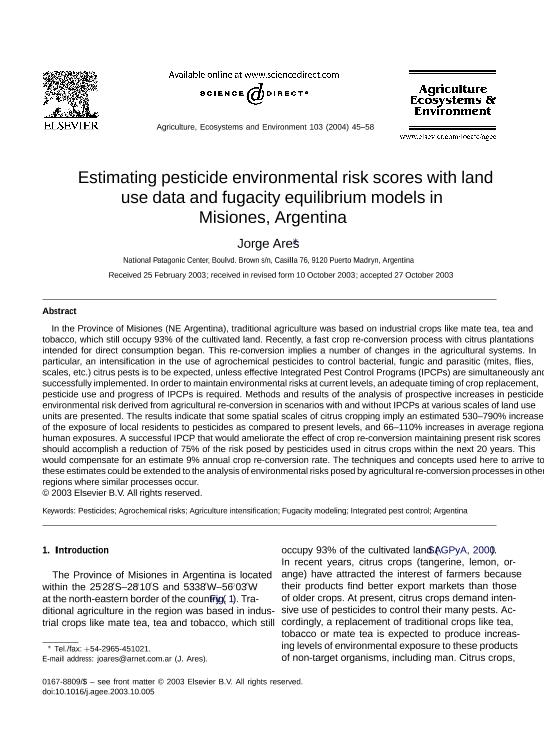Mostrar el registro sencillo del ítem
dc.contributor.author
Ares, Jorge Oscar

dc.date.available
2017-11-10T20:30:14Z
dc.date.issued
2004-01
dc.identifier.citation
Ares, Jorge Oscar; Estimating pesticide environmental risk scores with land use data and fugacity equilibrium models in Misiones, Argentina; Elsevier Science; Agriculture, Ecosystems and Environment; 103; 1; 1-2004; 45-58
dc.identifier.issn
0167-8809
dc.identifier.uri
http://hdl.handle.net/11336/27962
dc.description.abstract
In the Province of Misiones (NE Argentina), traditional agriculture was based on industrial crops like mate tea, tea and tobacco, which still occupy 93% of the cultivated land. Recently, a fast crop re-conversion process with citrus plantations intended for direct consumption began. This re-conversion implies a number of changes in the agricultural systems. In particular, an intensification in the use of agrochemical pesticides to control bacterial, fungic and parasitic (mites, flies, scales, etc.) citrus pests is to be expected, unless effective Integrated Pest Control Programs (IPCPs) are simultaneously and successfully implemented. In order to maintain environmental risks at current levels, an adequate timing of crop replacement, pesticide use and progress of IPCPs is required. Methods and results of the analysis of prospective increases in pesticide environmental risk derived from agricultural re-conversion in scenarios with and without IPCPs at various scales of land use units are presented. The results indicate that some spatial scales of citrus cropping imply an estimated 530–790% increase of the exposure of local residents to pesticides as compared to present levels, and 66–110% increases in average regional human exposures. A successful IPCP that would ameliorate the effect of crop re-conversion maintaining present risk scores should accomplish a reduction of 75% of the risk posed by pesticides used in citrus crops within the next 20 years. This would compensate for an estimate 9% annual crop re-conversion rate. The techniques and concepts used here to arrive to these estimates could be extended to the analysis of environmental risks posed by agricultural re-conversion processes in other regions where similar processes occur.
dc.format
application/pdf
dc.language.iso
eng
dc.publisher
Elsevier Science

dc.rights
info:eu-repo/semantics/openAccess
dc.rights.uri
https://creativecommons.org/licenses/by-nc-nd/2.5/ar/
dc.subject
Pesticides
dc.subject
Agrochemical Risks
dc.subject
Agriculture Intensification
dc.subject
Fugacity Modeling
dc.subject
Integrated Pest Control
dc.subject
Argentina
dc.subject.classification
Otras Ciencias Agrícolas

dc.subject.classification
Otras Ciencias Agrícolas

dc.subject.classification
CIENCIAS AGRÍCOLAS

dc.title
Estimating pesticide environmental risk scores with land use data and fugacity equilibrium models in Misiones, Argentina
dc.type
info:eu-repo/semantics/article
dc.type
info:ar-repo/semantics/artículo
dc.type
info:eu-repo/semantics/publishedVersion
dc.date.updated
2017-11-03T20:02:37Z
dc.journal.volume
103
dc.journal.number
1
dc.journal.pagination
45-58
dc.journal.pais
Países Bajos

dc.description.fil
Fil: Ares, Jorge Oscar. Consejo Nacional de Investigaciones Científicas y Técnicas. Centro Científico Tecnológico Conicet - Centro Nacional Patagónico; Argentina
dc.journal.title
Agriculture, Ecosystems and Environment

dc.relation.alternativeid
info:eu-repo/semantics/altIdentifier/doi/http://dx.doi.org/10.1016/j.agee.2003.10.005
dc.relation.alternativeid
info:eu-repo/semantics/altIdentifier/url/http://www.sciencedirect.com/science/article/pii/S0167880903003852
Archivos asociados
